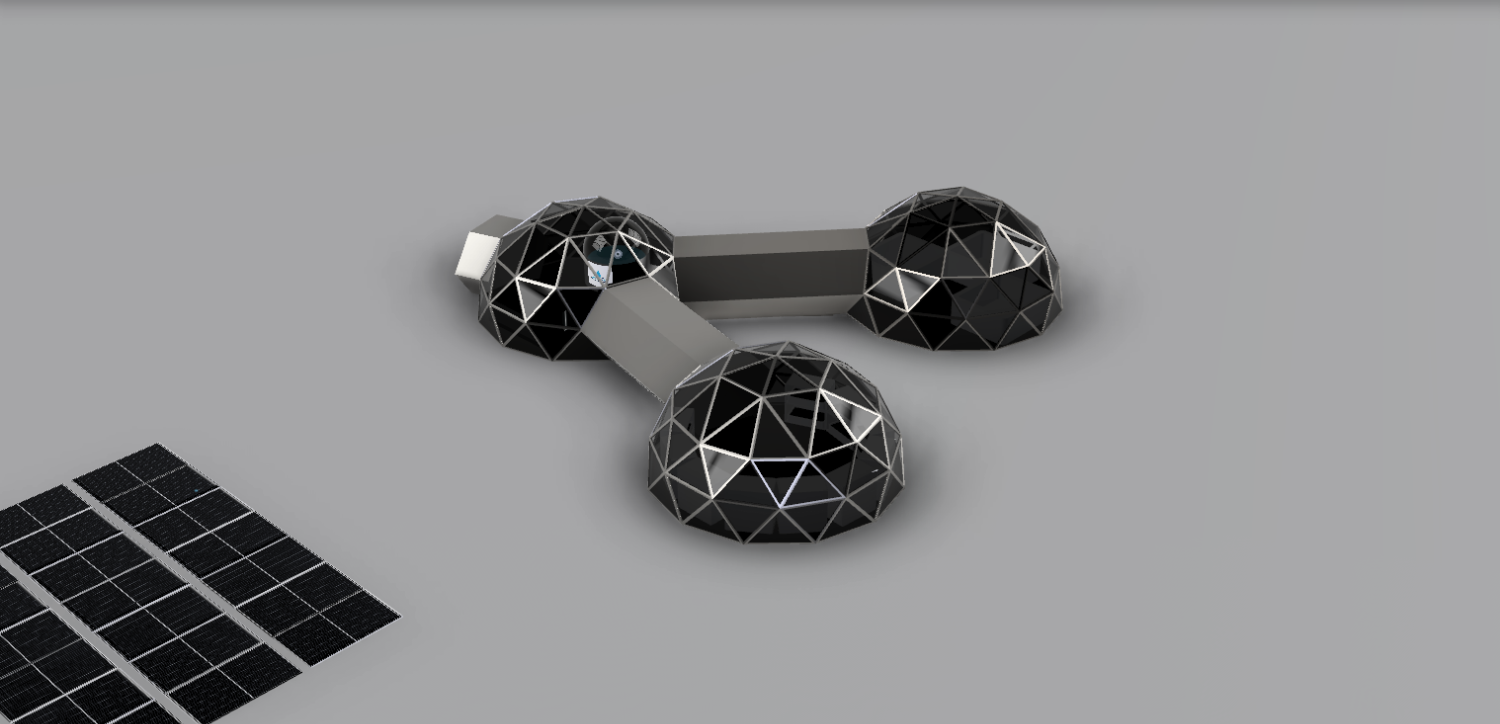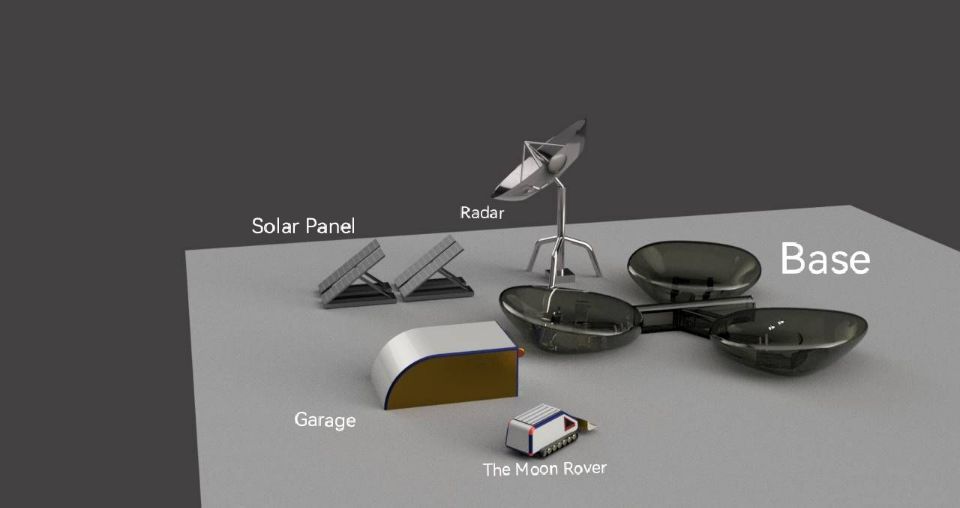Moon Camp Pioneers Gallery 2021-2022
In Moon Camp Pioneers each team’s mission is to 3D design a complete Moon Camp using Fusion 360. They also have to explain how they will use local resources, protect astronauts from the dangerous of space and describe the living and working facilities.
Team: Conatur Lunar
Oldham Hulme Grammar School Oldham United Kingdom 17, 16 4 / 2 Second Place – ESA Member states
External viewer for 3d project
|
Project description
Under mission Conatur Lunar, our base Sanctuarium intends to be an innovative research facility, looking to further uncover and gain understanding into the geological history of the lunar surface.
Investigation through our laboratory, involving the in-depth analysis of formation and composition of moon dust, will be utilised in building a more accurate record of both the moon and our own planet’s past. Eventually, the data we collect will be used to inform modern-day advancements in lunar colonisation and exploration technology. Sanctuarium’s 3D model illustrates our design’s intention to provide protection, whilst also allowing for the undertaking of tasks. The underground plan is comprised of habitation, technical, agricultural and storage regions, which provide our crew of four with the tools necessary to live and work comfortably during the course of their mission. While Conatur Lunar’’s preliminary objectives are examination based – results obtained could eventually enable us to move towards a more complex third phase.
|
|||
|
2.1 Where do you want to build your Moon Camp?
We plan to situate our base on the edge of the De Gerlache Crater. Located along the southern limb of the moon, (with lunar coordinates 88.5°S, 87.1°W) it provides an Earth-facing orientation which is ideal for minimising travel distances and communication channels. Evidence supported by 24,000 wide-area and 31,500 narrow-area camera images denotes that our site is situated close to a point of eternal illumination. With daily minimum and maximum values sitting at 64% and 98%, De Gerlache can be further viewed as favourable due to its ability to permit the harvest of solar energy. The crater rim itself provides ideal terrain, serving as an area of flat land that will be utilised to place landing pads, solar panels and research equipment. Alongside this, the presence of lunar ice deposits will allow for the autonomous harvest of water. 2.2 How do you plan to build your Moon Camp? Describe the techniques, materials and your design choices.
The earliest stage of construction for our base intends to be unmanned. We will allow the use of robotics and a 17.6m diameter tunnel boring machine to drill into the side of the crater. By plotting the landing coordinates close to a known lava tube, we allow for further future expansion should we need it. The underground site illustrates a natural defence against radiation and impacts from debris, in addition to capitalising from the natural environment, (ie. reduction of labour by adapting natural cavity space). Upon accessing the crater the drill will be used to elongate space available, and robotics will follow behind releasing inflatables to prevent the structure from caving in. Atmospheric conditions will be fabricated through the transport of gases such as H₂, N₂ and O₂, while the robotics will harvest lunar soil as 3D printable material to build the foundations and external walls. They will also assemble the external landing pads necessary for enabling the next phase of transition. The next stage will send up our manned crew alongside the more specific equipment and materials in need of installation – this will include the fitting of specialist equipment such O₂ reclaimers, assembly of our rovers and the reinforcement of any structures prone to damage in transit. Following human intervention, the base should be fully functional and the crew will become stationed, with the robotics now serving as appliances for assistance and repair. 2.3 The environment on the Moon is very dangerous for the astronauts. Explain how your Moon Camp will protect them. (maximum 150 words)
Various hazards pose high risk, each of which must be tackled individually to preserve life: Radiation lies at 60 microsieverts, (approximately 200 times Earth levels.) The crew will wear dosimeters to monitor their degree of exposure. Areas under heavy occupation ie. sleeping and living quarters, will contain augmented shielding as further mitigation. The projected temperature gradient of our base can be heated to meet the requirements for human habitation using solar power and exchange systems. Radioisotope Thermoelectric Generators, (RTGs,) will be used as a backup system. The implementation of hermetic seal leak detectors, modifying technologies like MFS-TOPS-42 will alert and allow the crew to leave the base via an airlock should any errors in sustaining atmospheric conditions occur. Lightweight physical barriers eg. stuffed Whipple shields, will reinforce surface structures deemed vulnerable by increasing their protection against hypervelocity impacts. Base design provides further natural defence, by utilising crater space situated underground. |
|||
|
2.4 Explain how your Moon Camp will provide the astronauts with:
|
Water
|
Food
|
Power
|
Air
|
|
The majority of the astronaut’s water replacements will be obtained from lunar ice deposits. The base will utilise the Shuttle Fuel Cell (SFC), the Oxygen Generator System (OGS), Carbon Dioxide Removal Assembly and the Sabatier Reaction (SR) in order to replenish and recycle a constant water supply: SFC: 2H₂ + O₂ →2H₂O + electricity Filtering waste waters such as urine and shower water, alongside controlled moisture removal from cabin air will ensure that no possible outlet goes to waste. Secondary sources obtained through lunar soil are applicable but not ideal as they produce relatively low yields. As it is used across a wide range of applications, ie. from electrolysis to hygiene, we must administer support following system failure. In the case of redundancy, our base has emergency H2O tanks fitted that can be used while the problem is fixed, (see air.) |
When striving towards longevity, growing fresh produce will be exemplary as we are more likely to sustain bodily vitamin and mineral requirements for prolonged periods, as opposed to taking multivitamins. Low concentrations of nitrogen in lunar soil, (5ppm,) means we will first ship a quantity over from Earth with seeds and fertiliser. Therefore, organic waste matter will be recycled. To begin with, the underground aquaponics farm will ensure a yield for mission continuity. However, there is high energy demand involved as light intensity is proportional to plant growth. We will look to develop Advanced Plant Habitats in a secondary phase of production. Employing a range of LEDs, as well as a clay substrate controlling the release of fertiliser, water and minerals, and sensors to monitor plant growth. The reduction in need for daily physical interaction with the plants and higher energy intensity results in improved suitability to longer term settlement. |
The main source of electricity for our crew will come from solar panels with a high concentration of photovoltaic cells per cm². Combined with the location’s daily light rates, we will maximise the efficiency of solar radiation absorption, consequently used in power generation. In addition, hydrogen fuel cells will be used to store excess energy above station demand, meaning that during times of low illumination, consumption is still pliable. Where possible, diversion of the power supply from the laboratory will also be focused towards life systems. As mentioned under our proposals in managing risks, the crew will have access to RTG should they need it: but due to the risks associated with radioactive contamination, this is considered to be more of an emergency outlet. Hence, we will implement it as an outside source, situated on the crater rim in a reinforced container underground. |
Gases brought with the robotics will ensure that an atmospheric environment is initially set up for the astronaut’s arrival. The Sabatier Method not only produces water, but when followed by electrolysis will be our main method to obtain oxygen. Extraction from regolith can also occur and will be utilised in conjunction with instances that will benefit from the metal alloy products formed at the anodes. While it is true that oxygen intake and carbon dioxide expulsion will occur through the growth of plants on the base, conditions will be monitored and controlled to such a degree that affectation on the base will be considered to be negligible. Baroscopic conditions including gas composition, pressure and moisture levels will all be monitored for the duration of the mission, and air tanks must be used as redundancy in the case that air replenishment systems fail. |
|
2.5 Explain what would be the main purpose of your Moon Camp.
Conatur Lunar’s purpose can be categorised into short term, (ST) medium term, (MT) and long term, (LT) schematics: INVESTIGATIVE ORIENTATION: → to combine the STEM disciplinaries of the crew members and current knowledge with on-site experimental evidence in order to gain a better insight into both lunar and by association, Earth’s geological history. (ST) → to use the personal experience and mission itself to improve upon techniques, troubleshooting the prospect of space travel. (MT) ADVANCEMENT ORIENTATION: → to strive towards the possibility of lunar colonisation, pushing existing successful technologies to become applicable to larger numbers and demographics of life. (LT)If Sanctuarium is proven effective in establishing a high tech work environment capable of sustaining human life, our overall aim will be to learn and move from our pioneering research towards improved viability, and in an ideal scenario, contribute towards the creation of commercial and domestic lunar life. |
|||
|
3.1 Describe a day on the Moon for your Moon Camp astronaut crew.
Throughout time inhabiting Sanctuarium, the daily routine will consist of maintenance and research balanced with equally important leisure time, in order to maintain a healthy work-life balance. Whilst there would be no staggered night shifts, a rota would determine an ‘on call’ astronaut for each night in case of emergencies. The astronauts would begin their shifts with hygiene tasks. Using rinseless shampoo would massively reduce water consumption and alleviates the struggle of microgravity. Breakfast in the first hour of the shift would consist of nutrient rich items like scrambled eggs, to increase their daily calorie intake to around 2,800 calories. We propose to take these in biodegradable packaging, to increase sustainability on board. This would be followed by biomedical monitoring tests to check how their body is adjusting to the environment for future expeditions. The facility’s daily work assignments would include reporting on research data. As well as this key research function, crew would have to carry out essential maintenance tasks too. After checking to see if they have received communication from the control centre back on Earth, specific research tasks would be delegated. For lunch, a protein rich meal would be consumed, with meal variation for improved quality of life. Testing new ways to grow plants using LED technology would allow the growth of different fresh food to supplement dinner as well as develop further prospects of sustaining life in Space. Physical activity on the lunar base would be a key aspect of their lifestyles, including participating in exercise 1 hour a day to mitigate muscle deterioration. Communication in the evenings with family and friends will allow connection to Earth. Social time will greatly benefit the astronauts who will be with the same few people every day. Adaptive research can also take place, led by daily updates from other laboratories on Earth. In order to keep the astronauts healthy, after finishing any final maintenance tasks on the base they will retire to their bedroom for 8 hours sleep. The specially designed bunk beds allow sleeping bags to be attached to combat the issue of reduced gravity, to allow restful sleep to rejuvenate for the next busy day. We believe that the community of like-minded people will live together successfully on the base, given the opportunity to spend time working on what they enjoy individually as well as working collaboratively. |
|||




























